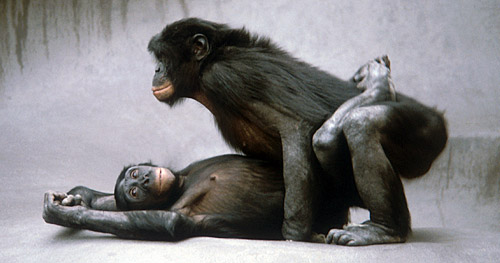
Fitted Women’s T-shirts
available now at Shop Skeptic!
By popular request our Skeptics t-shirts are now available in a fitted style for women. This classic form-fitted shirt by Bella has tapered short sleeves, a crew neck, and is 100% pre-shrunk cotton. The Skeptics Society logo is on the left sleeve. “Science Rules” or “Got Skeptic” is printed on the back of the shirt. Available in small, medium and large and extra large.
In this week’s eSkeptic we publish a hot and timely article by the world-renowned primateologist Frans de Waal, responding to a recent New Yorker article on bonobos, in which primate politics, both left and right, once again muddled the science. The spindoctoring of science for political purposes, of course, is a long and dishonorable tradition, so nothing new here in that regard. However, it is interesting that so many people wish to deny the undeniable relationship between humans and chimps, and at the same time cannot seem to help finding political meanings in primate behavior that supports either a liberal or conservative agenda. On so simple a question — how much sex and violence do chimpanzees and bonobos exhibit — rides so much political angst about human nature and culture. Fortunately the facts can help sort through the fiction, and Frans de Waal is just the scientist to be our guide.

Bonobos often adopt a “missionary” posture during copulation (photograph by Frans de Waal).
Bonobos, Left & Right
Primate Politics Heats Up Again as
Liberals & Conservatives Spindoctor Science
by Frans de Waal
Imagine that you’re a writer and you have decided to offer your readers a first-hand account of the politically correct primate, the idol of the left, known for its “gay” relations, female supremacy, and pacific life-style. Your focus is the bonobo: a relative of the chimpanzee, and genetically equally close to us as the chimpanzee. You go all the way to a place called the Democratic Republic of the Congo to see these darling apes frolic in their natural habitat, hoping to come back with new and exciting material.
Alas, you barely get to see any bonobos. You watch a few of them quietly sitting in the trees, eating nuts. That’s all. This is what happened to Ian Parker, who nevertheless managed to write thirteen pages of carefully crafted prose as a “far-flung correspondent” for The New Yorker. We learn about the “hot, soupy air,” the rainstorms, the mud streams, the sound of falling fruit shells, and his German host, Gottfried Hohmann, who is described as rather unsympathetic.1
The main message of Parker’s piece could of course have been that fieldwork is no picnic, but instead he went for profound revelation: bonobos are not nearly as nice and sexual as they have been made out to be. Given that the bonobo’s reputation has been a thorn in the side of homophobes as well as Hobbesians, the right-wing media jumped with delight. The bonobo “myth” could finally be put to rest. Parker’s piece was gleefully picked up by The Wall Street Journal and Dinesh D’Souza (yes, the same one who blamed 9/11 on the left), who accused “liberals” of having fashioned the bonobo into their mascot. D’Souza urged them to stick with the donkey.2
This might all have been amusing if it weren’t for the fact that these are not just political skirmishes. At issue is what we know. Parker presented his trip as a fact-finding mission that had unearthed revolutionary new insights. His message was that bonobos are killer apes, just like their cousins, the chimpanzees. The animal kingdom remained “red in tooth and claw,” as it ought to be.
Yet, the most striking cases of bonobo aggression that he reported have been known for decades, and actually didn’t come from the natural habitat, even less from first-hand observation by our brave explorer. A typical description was given by Jeroen Stevens, a Flemish biologist, of a gang of five bonobos assaulting a single victim at Apenheul Zoo, in the Netherlands. “They were gnawing on his toes. I’d already seen bonobos with digits missing, but I’d thought they would have been bitten off like a dog would bite. But they really chew. There was flesh between their teeth.”1
Many such cases have been documented at zoos over the years, and have actually led to changes in policies of how to keep bonobos. This is why I warned in Bonobo: The Forgotten Apenot to romanticize the species: “All animals are competitive by nature and cooperative only under specific circumstances.”3
The second part of Parker’s revisionist attempt was the suggestion that bonobo sexual tendencies have been grossly exaggerated. Since most observations of bonobo sex come from zoos, they can be safely ignored, we were told, on the assumption that captivity distorts behavior. The problem is, of course, the incongruity of considering zoo observations valid in relation to aggression, yet worthless in relation to sex. One either accepts both or rejects both.
Perhaps it is time to go over the evidence once again and see if bonobos are as special as they have been made out to be. Unfortunately, the evidence that we have is relatively old. The impression that there are new discoveries is merely a product of creative writing. The DRC is only now emerging from a bloody civil war that has kept field workers away. Knowledge about bonobos in their natural habitat has been at a virtual standstill for about a decade.
But there exists excellent field data from before this time. Combined with reports from captive apes, these provide a rather coherent picture. The most important fact, which has remained unchanged over the last three decades of bonobo research, is that there exist no confirmed reports of lethal aggression, neither from the field nor from captivity. For chimpanzees, in contrast, we have dozens of cases of adult males killing other males, of males killing infants, of females killing infants, and so on. This is in the wild. In captivity, I myself documented how two male chimpanzees brutally mutilated a third, castrating him in the process, which led to his death.4 There is absolutely no dearth of such information on chimpanzees, which contrasts greatly with the zero incidence in bonobos.
Reviewing chimpanzee violence in Demonic Males, Richard Wrangham went on to draw the following comparison with “the gentle ape,” the bonobo: “we can think of them as chimpanzees with a threefold path to peace. They have reduced the level of violence in relations between the sexes, in relations among males, and in relations between communities.”5
None of this is to say that bonobos live in a fairy tale. When first writing about their behavior, I spoke of “sex for peace” precisely because bonobos had plenty of conflicts. There would obviously be no need for peacemaking if they lived in perfect harmony. Sexual conflict resolution is typical of females, but also occurs among males: “Vernon regularly chased Kalind into the dry moat … After such incidents the two males had almost ten times as many intensive contacts as was normal for them. Vernon would rub his scrotum against Kalind’s buttocks, or Kalind would present his penis for masturbation.”6
It is entirely possible that one day we will discover serious, perhaps deadly aggression in this species, and it probably will be females collectively attacking a male, since this is the fiercest aggression seen at zoos (and a good argument against attributing female dominance to male “chivalry”). For now, however, bonobos offer the opposite picture. Whereas most observed chimpanzee killings occur during territorial disputes, bonobos engage in sex at their boundaries. They can be unfriendly to neighbors, but soon after a confrontation has begun, females have been seen rushing to the other side to copulate with males or mount other females. Since it is hard to have sex and wage war at the same time, the scene rapidly turns into socializing. It ends with adults from different groups grooming each other while their children play.
These reports go back to 1990, and come mainly from Takayoshi Kano, the Japanese scientist who worked the longest with wild bonobos.7,8 While writing Bonobo, I interviewed field workers, such as Kano and also Hohmann. Asking the latter how his bonobos react to another group, Hohmann replied: “It starts out very tense, with shouting and chasing, but then they settle down and there is female-female and male-female sex between members of the two communities. Grooming may occur, but remains tense and nervous.”9 This is not exactly the stuff expected of killer apes, although Hohmann did add that groups do not always mingle and that he never saw males from different groups groom.
Perhaps the bonobo’s peaceful image can be countered with descriptions of them catching and eating prey? Isn’t this violent behavior? Not really: feeding has very little to do with aggression. Already in the 1960s, Konrad Lorenz explained the difference between a cat hissing at another cat and a cat stalking a mouse. The neural circuitry of the two patterns is different: the first expresses fear and aggression, the second is motivated by hunger. Thus, herbivores are not any less aggressive than carnivores — as anyone who has been chased by a bull can attest. The fact that bonobos run after duikers and kill squirrels — which has been seen many times — is therefore best kept out of debates about aggression.
As for sex, I perceive the shyness of many scientists as a problem. It leads them to either ignore sexual behavior or call it something else. They will say that bonobos are “very affectionate,” when the apes in fact engage in behavior that, if shown in the human public sphere, would get you quickly arrested. Two females may be pressing vulvas and clitorises together, rapidly rubbing them sideways in a pattern known as genito-genital rubbing (or “hoka-hoka”), and Hohmann, who has seen this pattern many times, wonders: “But does it have anything to do with sex? Probably not. Of course, they use the genitals, but is it erotic behavior or a greeting gesture that is completely detached from sexual behavior?”1
Fortunately, a United States court settled this monumental issue in the Paula Jones case against President Bill Clinton. It clarified that the term “sex” includes any deliberate contact with the genitalia, anus, groin, breast, inner thigh, or buttocks. In short, when bonobos contact each other with their genitals (and squeal and show other signs of apparent orgasm), any sex therapist will tell you that they are “doing it.”10
Bonobos do it a lot, and not just between male and female. Nothing has changed in this regard. The only disagreement arose when Craig Stanford compared existing data in wild chimpanzees and bonobos. Stanford is an American primatologist who has studied chimpanzees but not bonobos, which may explain why he considered only adult heterosexual relations when claiming similar sex rates for both species.11 Since bonobos have sex in virtually all partner combinations, they were seriously short-changed by these calculations.
How much bonobos differ from chimpanzees was highlighted by a recent experiment on cooperation. Brian Hare and co-workers presented apes with a platform that they could pull close by working together. When food was placed on the platform, the bonobos clearly outperformed the chimpanzees in getting a hold of it. The presence of food normally induces rivalry, but the bonobos engaged in sexual contact, played together, and happily shared the food side by side. The chimpanzees, in contrast, were unable to overcome their competition.12 For two species to react so differently to the same experimental set-up leaves little doubt about a temperamental difference.
In another illustration, at a forested sanctuary at Kinshasa it was recently decided to merge two groups of bonobos that had lived separately, just so as to induce some activity. No one would ever dream of doing this with chimpanzees as the only possible outcome would be a blood bath. The bonobos produced an orgy instead.
In short, so long as we call sex “sex” and focus on known levels of intraspecific (as opposed to interspecific) violence, there is absolutely no reason to drop the claim that bonobos are relatively peaceful, and that sexual behavior serves a wide range of non-reproductive functions, including greeting, conflict resolution, and food sharing.
I understand the frustration of field workers with the image of bonobos as angels of peace, which is not only one-dimensional, but incorrect. On the other hand, anyone who objects to the occasional hyperbole (such as “chimpanzees are from Mars, bonobos are from Venus”), should realize that no one would ever have heard of the species — and no reporter would have considered them for a piece in The New Yorker — if they’d been described as merely affectionate. Possibly, one or two decades from now a new image of the bonobo will emerge, one more complex than what we have today. This is already happening thanks to detailed studies of their socio-ecology, observations that nuance the dynamics of female dominance, and video-analyses of their natural communication. No doubt, the return of bonobo field workers to Africa will significantly add to our knowledge.
But whatever we find out, a Hobbesian make-over of the bonobo is not to be expected any time soon. I just can’t see this ape go from being a gentle, sexy primate to a nasty, violent one. Japanese primatologist Takeshi Furuichi, perhaps the only scientist to have studied both chimpanzees and bonobos in the forest, said it best: “With bonobos everything is peaceful. When I see bonobos they seem to be enjoying their lives.”1
About the Author
Frans B. M. de Waal was trained as a zoologist and ethologist in the European tradition resulting in a Ph.D. in biology from the University of Utrecht, in 1977. In 1981, Dr. de Waal moved to the USA, first to Madison, Wisconsin, and now in a joint position in the Psychology Department of Emory University and at the Yerkes National Primate Research Center, both in Atlanta. He is known for his popular books, such as Chimpanzee Politics (1982), Peacemaking Among Primates (1989, which received the Los Angeles Times Book Award), Bonobo: The Forgotten Ape (1997), and his latest, Our Inner Ape (2006). His current interests include food-sharing, social reciprocity, and cultural transmission in primates as well as the origins of morality and justice in human society.
References & Notes
- Parker, I. (July 30, 2007). Swingers. The New Yorker: 48–61.
- D’Souza, D. (2007). Bonobo Promiscuity? Another Myth Bites the Dust. AOL Newsbloggers.
- de Waal, F. B. M. (1997). Bonobo: The Forgotten Ape, with photographs by Frans Lanting. Berkeley, CA: University of California Press, p. 84.
- de Waal, F. B. M. (1998 [1982]). Chimpanzee Politics: Power and Sex among Apes, Revised Edition. Baltimore, MD: Johns Hopkins University Press.
- Wrangham, R. W., & Peterson, D. (1996). Demonic Males: Apes and the Evolution of Human Aggression. Boston: Houghton Mifflin, p. 204.
- de Waal, F. B. M. (1989). Peacemaking among Primates. Cambridge, MA: Harvard University Press, p. 215.
- Idani, G. (1990). Relations between unit-groups of bonobos at Wamba: Encounters and temporary fusions. African Study Monographs 11: 153–186.
- Kano, T. (1992). The Last Ape: Pygmy Chimpanzee Behavior and Ecology. Stanford, CA: Stanford University Press.
- de Waal, F. B. M. (1997), p. 81.
- Block, S. (2007). Bonobo Bashing in the New Yorker. Counterpunch. http://www.counterpunch.org/block07252007.html
- Stanford, C. B. (1998). The social behavior of chimpanzees and bonobos. Current Anthropology 39: 399–407.
- Hare, B., et al. (2007). Tolerance allows bonobos to outperform chimpanzees on a cooperative task. Current Biology 17: 1–5.

Pouring Cold Water on a Runaway Trend

Put down that designer bottle of H20! Did you know that if you choose to get your recommended eight glasses a day from bottled water, you could spend $1,400 US dollars annually? That same amount of tap water would cost about 49 cents.
Wealthy nations like the United States have some of the cleanest, cheapest and best tasting tap water in the world. The US is also the world’s largest consumer of bottled water: 8.3 billion gallons in 2006 (about 26 gallons per person)! Will our rising demand for bottled water harm our nation’s aging water distribution and filtration infrastructure? And why are groups like Presbyterians for Restoring Creation boycotting bottled water?
On this week’s Skepticality, Derek & Swoopy speak to Kelly Comstock, an environmental engineer and hydrologist who specializes in potable drinking water filtration technology, to answer these questions — and get to the bottom of the bottled water debate.
Michael Shermer Spoonbending

Ever since the 1970s, spoonbending (and the bending of other cutlery, metal bars, and the like) has been held up as physical evidence for telekinesis, a form of PSI in which thoughts alone can allegedly be employed to alter the physical environment. In this episode, Michael Shermer attends a seminar on spoonbending and discovers the power of group think to actually bend metal! WATCH the video >









